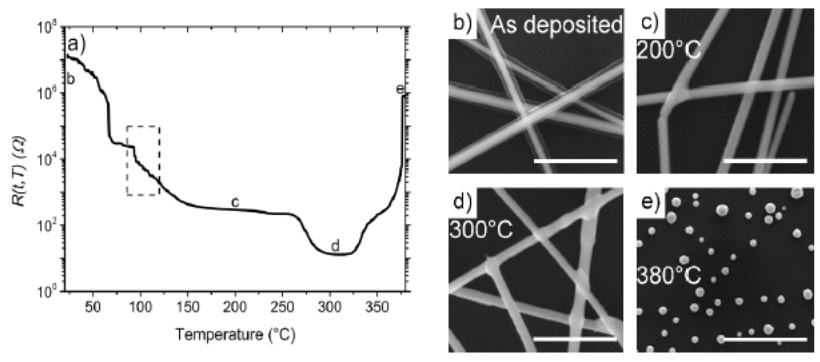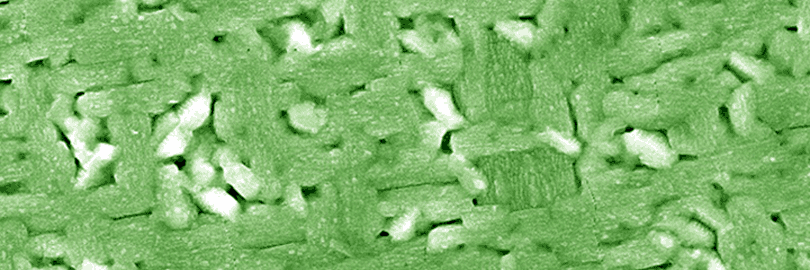Investigation of the physical properties of silver nanowire networks for transparent electrodes and transparent heaters:
- understanding the relationship between silver nanowire morphology & network density and the physical properties (electrical, optical, thermal…),
- investigating the effects of post-treatment such as thermal annealing on electrical properties,
- models of physical properties,
- integration of silver nanowire networks into devices.
- Sara Aghazade (PhD student)
- Theodora Papanastasiou (PhD student)
- João Resende (Postdoc)
- Dr. J.-P. Simonato, CEA-Liten, Grenoble (France)
- Prof. N.D. Nguyen (Liège, Belgium)
- Prof. Y. Bréchet, Grenoble INP (France)
Highlight
Silver nanowire (AgNW) networks can exhibit very good electrical, thermal and optical properties, especially after thermal annealing. We have recently shown (Langley, Nanoscale 2014) the effects of a thermal annealing which allows: i) the formation of efficient percolating pathways; and ii) the local sintering at junctions between nanowires leading to a low electrical resistance.
Above a certain annealing temperature Rayleigh instability does occur thus destroying the percolative nature of AgNW networks.
Such networks can also efficiently act as transparent heaters.
A comprehensive model has been developed for describing the physics of such nanostructured transparent heaters (Sorel et al., ACS 2014).
Contact
Team (Permanent staff)
Projects
- ANR FICHTRE (2014-2017)
- Soutien à l’Excellence et à l’Innovation - Grenoble INP (2012-2015)
- IDS FunMat (2011-2014)
FunSurf Research topics
- Atmospheric Chemical Deposition of Functional Materials
- Wet Chemistry & Surface Functionalization
- Transparent Conductive Materials
- Nanostructures for Chemical and Biological Sensors
 a) Evolution of the electrical resistance of a AgNW network during a continuous thermal ramp; b-e) SEM images of: (b) as-deposited sample and of specimen annealed for 10 minutes at different temperatures: (c) 200°C, first occurrence of observable sintering; (d) 300 °C all junctions are sintered; (e) 380 °C complete spheroidization of the network. The scale bars in images b), c) and d) are 1 µm whereas that of image e) is 4 µm. (Ref: D.P. Langley et al. Nanoscale, to be published)
a) Evolution of the electrical resistance of a AgNW network during a continuous thermal ramp; b-e) SEM images of: (b) as-deposited sample and of specimen annealed for 10 minutes at different temperatures: (c) 200°C, first occurrence of observable sintering; (d) 300 °C all junctions are sintered; (e) 380 °C complete spheroidization of the network. The scale bars in images b), c) and d) are 1 µm whereas that of image e) is 4 µm. (Ref: D.P. Langley et al. Nanoscale, to be published)Main publications
Afzal Khan, Viet Huong Nguyen, David Muñoz-Rojas, Sara Aghazadehchors, Carmen Jiménez, Ngoc Duy Nguyen, and Daniel Bellet
ACS Applied Materials & Interfaces, 2018,10 (22), 9208–1921. Stability enhancement of silver nanowire networks with conformal ZnO coatings deposited by atmospheric pressure spatial atomic layer deposition
Thomas Sannicolo, Nicolas Charvin, Lionel Flandin*, Silas Kraus, Dorina T. Papanastasiou, Caroline Celle, Jean-Pierre Simonato*, David Muñoz-Rojas, Carmen Jiménez, Daniel Bellet
Electrical Mapping of Silver Nanowire Networks: A Versatile Tool for Imaging Network Homogeneity and Degradation Dynamics during Failure. ACS Nano, 2018 12 (5), 4648–4659
M. Lagrange, T. Sannicolo, D. Muñoz-Rojas, B. Guillo Lohan, A. Khan, M. Anikin, C. Jiménez, F. Bruckert, Y. Bréchet, D. Bellet
Understanding the mechanisms leading to failure in metallic nanowire-based transparent heaters, and solution for stability enhancement. Nanotechnology 28 (5) 055709 (2017)
T. Sannicolo, M. Lagrange, A. Cabos, C. Celle, J.P. Simonato, D. Bellet.
Metallic Nanowire-Based Transparent Electrodes for Next Generation Flexible Devices: a Review. Small 12 (44) 6052–6075 (2016)
D. P. Langley, M. Lagrange, G. Giusti, C. Jimenez, Y. Bréchet, N.D. Nguyen, D. Bellet,
Metallic Nanowire Networks: Effects of Thermal Annealing on Electrical Resistance,Nanoscale, 6 (22) 13535-13543 (2014).
S. Sorel, D. Bellet, J.N. Coleman,
The relationship between material properties and transparent heater performance for both bulk-like and percolative networks, ACS Nano 8 (2014) 4805
D.P. Langley, G. Giusti, M. Lagrange, R. Collins, C. Jimenez, Y. Bréchet, D. Bellet,
Silver nanowire networks: physical properties and potential integration in solar cells, Solar Energy Materials & Solar Cells, 125 (2014) 318-324.
D.P. Langley, G. Giusti, C. Mayousse, C. Celle, D. Bellet, J.-P. SIimonato
Flexible transparent conductive materials based on silver nanowire networks: a review, Nanotechnology 24 (2013) 452001055709.



